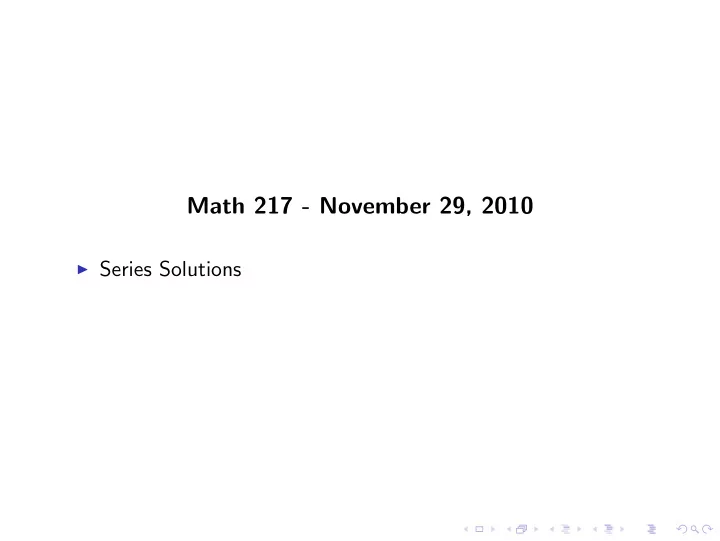

Math 217 - November 29, 2010 ◮ Series Solutions
1. What is an ordinary point? 2. What is a singular point? 3. Why do we care about ordinary points and singular points? 4. If you find a series solution at an ordinary point, what can you say about the radius of convergence for the series solution? 5. (1 − t 2 ) y ′′ − 6 ty ′ − 4 y = 0 Start with the series y = � ∞ n =0 c n t n . (a) Find a recurrance relation for the coefficients. (b) Use the recurrance relation to find c 0 , c 1 , c 2 , c 3 , c 4 , c 5 , and c 6 . (c) Try to find the solution to the equation. 6. (2 x − x 2 ) y ′′ − 6( x − 1) y ′ − 4 y = 0 Start with the series y = � ∞ n =0 c n ( x − 1) n . (a) Find a recurrance relation for the coefficients. (b) Use the recurrance relation to find c 0 , c 1 , c 2 , c 3 , c 4 , c 5 , and c 6 . Hint: 2 x − x 2 = 1 − ( x − 1) 2 (c) Try to find the solution to the equation.
1. What is an ordinary point? Solution: See page 518. 2. What is a singular point? 3. Why do we care about ordinary points and singular points? 4. If you find a series solution at an ordinary point, what can you say about the radius of convergence for the series solution? 5. (1 − t 2 ) y ′′ − 6 ty ′ − 4 y = 0 Start with the series y = � ∞ n =0 c n t n . (a) Find a recurrance relation for the coefficients. (b) Use the recurrance relation to find c 0 , c 1 , c 2 , c 3 , c 4 , c 5 , and c 6 . Solution: c n +2 = n + 4 n + 2 c n (c) Try to find the solution to the equation. 6. (2 x − x 2 ) y ′′ − 6( x − 1) y ′ − 4 y = 0 Start with the series y = � ∞ n =0 c n ( x − 1) n . (a) Find a recurrance relation for the coefficients. (b) Use the recurrance relation to find c , c , c , c , c , c , and c .
Lecture Problems 7. Use a substitution to transform the differential equations (a) ( x + 1) 2 y ′′ − 2( x + 1) y ′ − y = x , y ( − 1) = 5 , y ′ ( − 1) = 2 (b) ( x + 1) 2 y ′′ − 2( x + 1) y ′ − y = x , y (3) = 5 , y ′ (3) = 2
Lecture Problems 7. Use a substitution to transform the differential equations (a) Solution: Use t = x + 1. ( x + 1) 2 y ′′ − 2( x + 1) y ′ − y = x , y ( − 1) = 5 , y ′ ( − 1) = 2 t 2 y ′′ − 2 ty ′ − y = t − 1 (b) Solution: Use t = x − 3. ( x + 1) 2 y ′′ − 2( x + 1) y ′ − y = x , y (3) = 5 , y ′ (3) = 2 ( t + 4) 2 y ′′ − 2( t + 4) y ′ − y = t + 3
8. Given the recurrance relation, complete the solution. c n +2 = − n + 4 n + 2 c n 9. Given the recurrance relation, complete the solution. c n +2 = ( n − 3)( n − 4) ( n + 1)( n + 2) c n
8. Given the recurrance relation, complete the solution. c n +2 = − n + 4 n + 2 c n Solution: c 2 n =( − 1) n ( n + 1) c 0 c 2 n +1 =( − 1) n 1 3(2 n + 3) c 1 9. Given the recurrance relation, complete the solution. c n +2 = ( n − 3)( n − 4) ( n + 1)( n + 2) c n Solution: y = c 0 (1 + 6 x 2 + x 4 ) + c 1 ( x + x 3 )
10. Given the recurrance relation, find the solution to the DE c 2 = 1 c n +2 = c n − 2 c n − 1 2 c 0 , 11. Given the recurrance relation, find the solution to the DE c n +2 = c n − 4 + n 2 c n +2 c 2 = c 3 = c 4 = c 5 = 0 , ( n + 1)( n + 2)
Recommend
More recommend